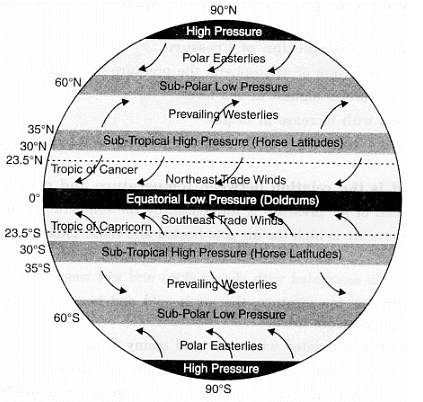Class 7 Geography Chapter 4 Question Answers - Air
Q1. What is global warming? What is its affect?
Ans:
When the heat retained through greenhouse gas increases the temperature of the earth, it causes global warming:
- The plants maintain the balance of gases. However this balance is upset by burning fuels such as coal, petroleum oil and large scale deforestation.
- This rise in temperature causes the snow in coldest parts to melt.
- As a result the sea level rises causing floods in the coastal areas.
- This may bring changes in weather and climate leading to extinction of certain plants and animal species.
Q2. Describe the composition of the atmosphere.
Ans:
Composition of the Atmosphere:
- The air we inhale while breathing is actually a mixture of numerous gases.
- Nitrogen and oxygen are two gases which make up the most of the atmosphere.
- Carbon dioxide, helium, ozone, argon and hydrogen are found in lesser quantities.
- Tiny dust particles are also present in the air.
 Types of Rainfall
Types of Rainfall
Q3. Explain how the oxygen and carbon dioxide balance is maintained in air?
Ans:
Green plants use carbon dioxide to make their food and during this process release oxygen:
- Humans and animals release carbon dioxide and take oxygen from air.
- The amount of carbon dioxide released by them is equal to amount used by plants
- to make their food. Hence a balance is maintained.
- But now the excess of carbon dioxide is released by burning of fuels. The reduction in number of plants upset the balance of gases like carbon dioxide affecting earth’s weather and climate.
Q4. Explain the circulation of air in atmosphere.
Ans:
When air is heated it expands, becomes lighter and rises up:
- Cold air is dense, so, it sinks down.
- When hot air rises up, cold air from surrounding areas fills in the gap.
- This is the process of circulation of air.
NOTES: News reports around the world
- Due to burning of fuels and cutting of trees C02 level are increasing
- Globed sunscreen thinned
- Warning unstoppable
- It can bring back Jurassic era.
Q5. Which layer the most suitable conditions for flying aeroplanes?
Ans:
Stratosphere:
- The stratosphere lies above the troposphere.
- It extends up to a height of 50 km.
- This layer is almost free from clouds.
- No weather phenomenon occurs in this layer making conditions most ideal for flying aeroplanes.
- Stratosphere contains a layer of ozone gas.
- It protects living beings from the harmful effects of the sun rays.
Q6. Which is the uppermost layer of the atmosphere?
Ans:
Exosphere:
- The uppermost layer of the atmosphere is known as exosphere.
- This layer has very thin air.
- Light gases like helium and hydrogen float into the space from here.
Weather and Climate:
Notes: Many questions are asked about days conditions especially on an important day like cricket match or wedding etc. Questions like’ will it rain or will it be sunny; etc. basically are related to day’s weather. Such questions are not asked about climate
Q7. What is the relation between temperature and pressure?
Ans:
Distribution of air pressure is influenced by the temperature of the area:
- Where temperature is high the air gets heated and rises. This creates a low pressure area.
- Low pressure is associated with cloudy skies and wet weather.
- In areas with low temperature, the air is cold and heavy so, it sinks down. This creates a high pressure area.
- High pressure is associated with clear and sunny skies.
- Air always moves from high pressure to low pressure areas.
Q8. What are the various categories of wind? Explain with a diagram.
Ans:
Winds can be broadly divided into three types:
- Permanent winds – which blow constantly throughout the year in a particular direction.
Example, easterlies and westerlies. - Seasonal winds – which change directions in different seasons. For example, monsoon winds.
- Local winds – blow only during a particular period of the day or the year in a small area. For example, land or sea breeze, or loo.
 Major Pressure Belts and Wind System
Major Pressure Belts and Wind System
Q9. Describe the fury of cyclone taking example of ‘Super cyclone’ of Odisha.
Ans:
Odisha on eastern sea coast of India is prone to cyclones originating in Bay of Bengal.
- Odisha was hit by cyclone on 17th-18th October 1999 and again on 29th October.
- Cyclone originated as a ‘depression’ in the Gulf of Thailand near Port Blair.
- It moved in northwest direction on 25th October and intensified into super cyclone and hit Odisha.
- Wind speed was upto 260 km/hr which lasted for 36 hours.
- Trees were uprooted kutcha houses, roof tops industrial sheds etc blown away.
- Power supply and communication lines damaged.
- Continues rains flooded the major rivers. Tidal waves swept 20 km of inland areas including cities of Bhubaneshwar and Cuttack and destructed 28 coastal towns.
- 7-10 m high tidal waves caused damage to paddy crops, vegetables fruits and agricultural land turned infertile due to salination.
- 13 million people were affected. Livestock was killed.
- Plantations of teak, sal, bamboo, mangrove forests of Paradeep and Konark disappeared.
Q10. How are clouds formed? How do clouds cause precipitation?
Ans:
- When water vapour rises, it starts cooling.
- Water vapour condenses which results in formation of droplets of water.
- These droplets hanging in the air above are called clouds.
- Clouds are masses of these water droplets.
- When these droplets of water become too heavy to float in the air, they come down as precipitation.
|
63 videos|371 docs|46 tests
|
















